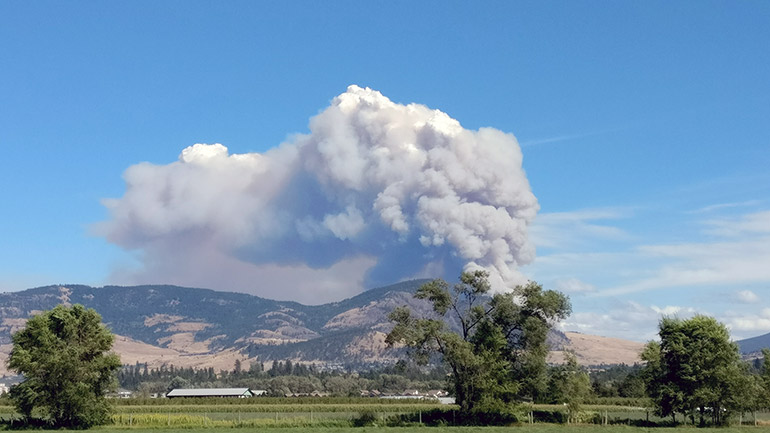
A plume of smoke rises above the southern British Columbia community of Joe Rich during the 2017 wildfire season. Communities across Canada are facing an increased need to plan for wildfire prevention. (Credit: Troy McMillan)
New research highlights state of local adaptation planning in Canada
Extreme forest fires, urban flooding and severe storms make frequent headlines across Canada as these events become more prominent and destructive.
Estimated to cost Canadian communities $5 billion a year by 2020, the price-tag of responding to climate change impacts could grow to $43 billion a year by 2050, and new research suggests the response requires involvement from all levels of government, industry and the public.
Over the past year, researchers from the University of British Columbia and the University of Waterloo worked with the Federation of Canadian Municipalities to conduct a survey studying municipal adaptation planning across Canada. Building on results from a similar survey in 2012, the research team found that over the past 10 years, above-average rain and snowfall and more severe storms are the most frequent weather events experienced by local governments.
"Canada's economic well-being depends on adapting vital infrastructure to this new reality," says Kevin Hanna, director of the Centre for Environmental Assessment Research, in the Irving K. Barber School of Arts and Sciences at UBC's Okanagan campus, and one of the project's leaders.
"These effects are driving important planning discussions and decisions about how to adapt to a changing climate," Hanna says. "More than half of local governments surveyed have initiated formal adaptation planning discussions in their community within the last four years."
"Canada's municipalities influence half of the country's greenhouse gas emissions. Critical physical and natural infrastructure is especially susceptible to changes in the climate," says Mark Seasons, professor with the School of Planning at the University of Waterloo. "All levels of government, industry and the public must work together to reduce emissions and respond to climate impacts."
The 2018 Climate Change Adaptation Survey of Canadian Municipalities ran from January to April 2018, and was open to all local governments in Canada. Other key findings from the survey include:
- Municipal engineering and public works, planning and traditional departments such as emergency management and public safety play an increasingly important role in adaptation planning.
- Results show that adaptation planning is more often undertaken on an as-needed basis, such as for infrastructure projects or risk assessments, than as part of a broader plan or strategy.
- Very few local governments have one or more full-time staff dedicated to adaptation planning or related initiatives.
- Local governments are increasingly using climate change and other data to make adaptation-related decisions.






